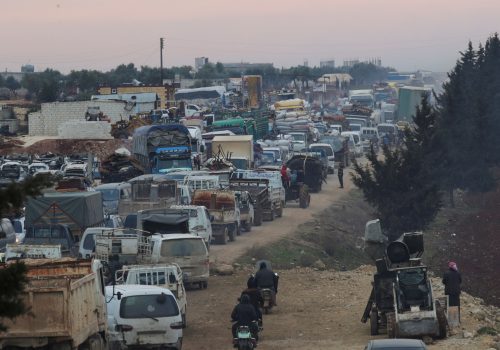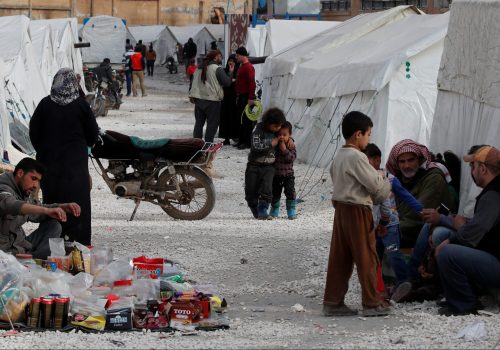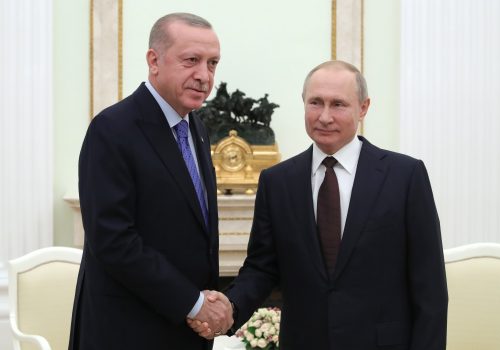Amid US uncertainty in Syria, Kurdish YPG eyes bolstering ties with Russia
Insofar as it exists, international attention on Syria in recent weeks has been fixated on the country’s northwestern province of Idlib and surrounding areas. Attention is of course needed considering that since December 2019, upward of 1 million internally displaced persons, have been pushed north toward Turkey’s border by the Bashar al-Assad regime and its allies advancing from the south and the east. The vast majority of those forced to flee have found themselves languishing in dire humanitarian circumstances.
As a result, the situation in Idlib will reverberate beyond the province’s borders, reshaping the strategic dynamics of the battlefield and the policy-making calculations of key state and non-state actors toward other spheres of the conflict. Of particular concern to the United States should be the increasingly apparent signs of potential convergence between the Kurdish-led Syrian Democratic Forces (SDF)—Washington’s partner in the war against the Islamic State of Iraq and al-Sham (ISIS)—and the Assad regime’s chief sponsor, Russia. Indeed, the creeping possibility for cooperation between those two parties borne of a shared sense of strategic necessity now appears all the more likely following the launch of Turkey’s Operation Spring Shield on March 1.
While the Kurdish People’s Protection Units (YPG) has a history of opportunistically working with the Assad regime when military operations necessitate, there is some reason to believe that a qualitative shift in relations could be underway. Underscoring this point, a Kurdish YPG general told this author that following recent developments, “There are many things that we are working on with the Syrian regime and Russia. In the future, there will be great success between us.” Since US President Donald Trump essentially granted Ankara a carte blanche to attack Kurdish forces in October 2019 by ordering the redeployment of US troops away from northeastern Syria, YPG leadership is said to be reassessing the strategic importance of its ties with what is an increasingly unreliable Washington, and is looking to further diversify its portfolio of international partners, with an eye toward strengthening ties with Russia.
Following that October 2019 Turkish intervention—Operation Peace Spring—the YPG struck a deal with Russia and the Assad regime allowing them to move their forces into areas previously under Kurdish control to deter Turkey and its Syrian National Army proxy forces from pressing further into territory east of the Euphrates. However, discussions and agreements between the SDF’s YPG leadership and the Assad-Russia axis do not end there. The SDF’s political wing has confirmed, that it is engaged in discussions with Moscow over the terms of any future reconciliation with the Assad regime.
Further highlighting possible coordination between the YPG and the Assad-Russia axis, one Kurdish source told a Turkish journalist that collaboration with Russia and the Assad regime is ongoing, and that the YPG expects those parties to come to recognize the indispensability of the Kurds in the fight to extricate Afrin of Turkish-backed Syrian army elements, who have been occupying that area since 2018. While this has yet to happen, likely because Russia remains circumspect about further angering Turkey by openly working with the YPG, the fact that such discussions have happened and will likely be revisited should be a point of concern for Washington.
Furthermore, reports have already surfaced suggesting that the YPG has fought with the Assad regime in Western Aleppo against Turkish-backed forces, although the militia has denied this. Indeed, according to other reports, the United States has already cautioned the YPG to avoid fighting alongside the regime against Turkish interests in Idlib and Afrin and has said that if it does so, US support will not be forthcoming. Notwithstanding, closer collaboration between the YPG and the Assad-Russia axis is far from a foregone conclusion, and depends largely upon how tensions between Moscow and Ankara unfold in Idlib.
While Russian President Vladimir Putin has always held Turkey as the bigger prize as part of his strategy of sowing divisions between NATO members, in the context of a further deterioration in relations over Idlib, the Kurds may prove to be a useful tool to turn up the pressure on Ankara. This move may accompany policies of once again closing the air space over Afrin and the Euphrates Shield areas and loosening restrictions on the YPG’s presence along Syria’s northeastern border agreed to by Putin and Turkish President Recep Tayyip Erdogan in October 2019. In recent discussions with this author, a senior member of the opposition Kurdish National Council said that he has strong reason to believe that if relations between Turkey and Russia once again start to whither, then Moscow will engage in a serious exploration of the ways that it can “use” the YPG as a tool to pressure Ankara to step back in line.
Some may point to the possibility of increased YPG-Russia-Assad strategic cooperation as evidence of the inherent flaws in the US’ operational model of fighting by, with and through a local non-state actor like the YPG-led SDF. Such detractors may argue that the relationship with such local partners is only ever going to be characterized by short-term transactionalism, and that it was inevitable that the SDF would go on to pursue reconciliation agreements with the Assad regime through Russia in an effort to secure at least some of its local interests, not to mention in order to avoid a possible military standoff. That political actors—state and non-state—look out for their own interests is however such an axiomatic point that it borders on the banal. The SDF committed itself in partnership with the United States as patron to a grueling, years long campaign against ISIS, and sacrificed 11,000 of its own fighters as a consequence. Ultimately, it was the US abandonment in October 2019 of the SDF and its accompanying ‘astrategic approach’ toward areas east of the Euphrates, and indeed the broader Syrian war, that accelerated the SDF’s drift toward the Russia-Assad orbit.
The aforementioned YPG general told this author in reference to President Trump’s facilitating of Turkey’s Operation Peace Spring that, “We do not deny the success that we achieved [against ISIS] thanks to the Americans, but in recent times, everything between us failed, and most important, they let us down in the international field.” He added, “There is no trust like before.” To reiterate: it is within the context of dwindled trust that the YPG-led SDF’s flirtations with Russia and Assad must be understood. The suddenness with which Trump’s redeployment decision was announced, and the subsequent ambiguous force mandate given to US troops to “protect the oil,” left the SDF leadership feeling that a final US withdrawal could be unilaterally announced by the mercurial US president any day, particularly as the conflict heats up in Idlib. As the YPG general explained, “There is no solution for us, and we need an international force behind us, that is why we are making agreements with Assad and Russia.” Yet, once again, it is important to maintain perspective. After all, the SDF is still engaged in anti-ISIS operations with US Special Operations Forces, namely in far eastern Syria.
However, in the face of increasing questions about sustained US commitment, the long-term viability of the SDF project, and the inevitable day of reckoning with the Assad regime, it makes sense that the YPG would seek to hedge its bets with Russia, which will maintain the role of kingmaker in Syria for many years to come. However, until Assad and Russia can totally supplant the Autonomous Administration—or gently bring the two together through negotiations—an arrangement may emerge in which the regime enjoys a degree of nominal ‘sovereign control’ while the SDF gets to maintain much of its political and security structures. For now at least, this may be the best of bad options for both the SDF and Russia, particularly as it may help to forestall another Turkish intervention reminiscent of October 2019 by giving the impression that Syrian sovereignty has returned—an outcome in the interests of both parties.
One former senior Pentagon official who was heavily involved in working with the YPG described their situation recently to this author: “The YPG are survivors and have been put in a position where they have to work a variety of relationships to remain viable and hopefully get integrated into some eventual peace process.” Still, the contradictions of Russian policy in the trans-Euphrates, where it has to tend to Ankara’s concerns over the YPG while trying to facilitate a rapprochement between the latter and an Assad regime that is determined to recover full sovereignty, leaves an exploitable space for the United States to reassert itself. Yet, this largely depends upon whether a US president—be it Trump or a democrat—discovers the will to do so.
Matthew Ayton is a PhD researcher focusing on the Syrian war, specifically in the context of US foreign policy and its support for Syrian non-state actors.
Image: Fighters of Syrian Democratic Forces (SDF) take part in the funeral procession of Kurdish fighters who were killed during clashes in northeastern Syria (Reuters)



